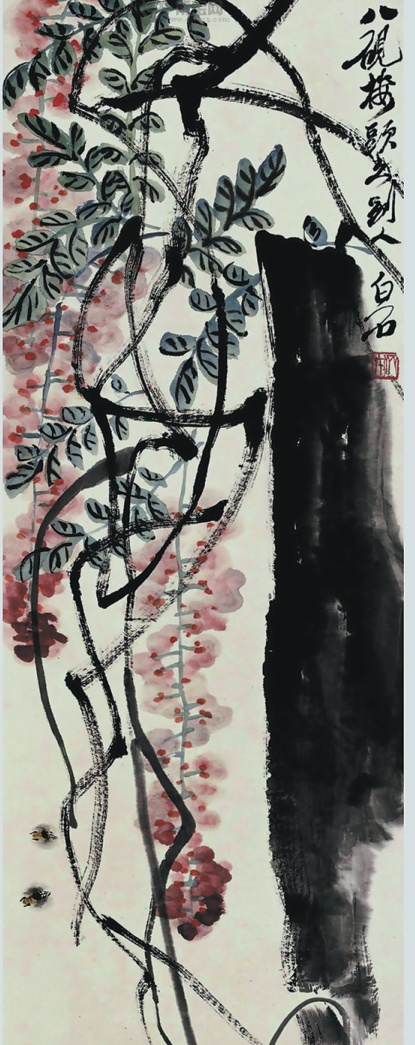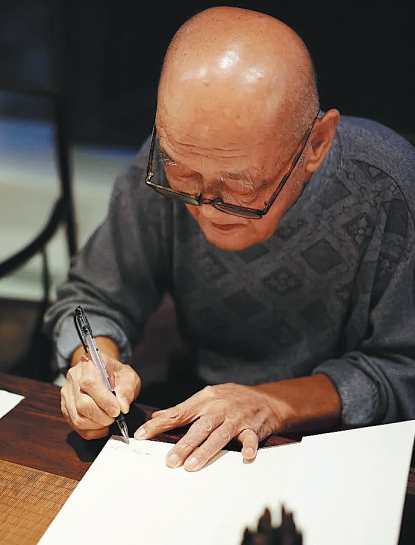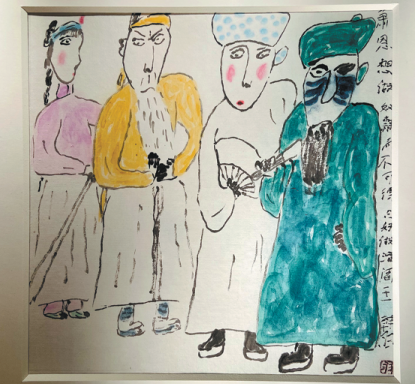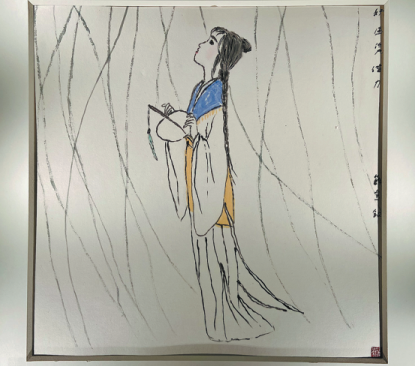Going beyond the confines of time
Exhibition showcases works of two artists, one in his 90s and the other deceased, as it examines the cultural and spiritual links between them, Lin Qi reports.

The 20-minute animation, The Three Monks, released in 1981, was a widely acclaimed production by Shanghai Animation Film Studio. The story revolves around the refusal of three Buddhist monks to share the responsibility of fetching water from a river down the mountain from where their temple is situated, and they end up having nothing to drink.
The animation won the Jury Prize Silver Bear for short film at the 32nd Berlin International Film Festival in 1982.
The Three Monks has been seen by generations of Chinese but few knew that the mastermind behind the three characters was Han Yu, a comic artist and painter based in Hebei province.
His talent brought Han wide recognition and numerous art prizes. In addition to that, the 90-year-old is noted for his discerning taste in classical Chinese ink paintings.
Han especially loves the art of Qi Baishi, one of China's preeminent 20th-century artists.
He has researched and written extensively about Qi's work and, in June, he published What I've Learned From Qi Baishi, a collection of 50 essays sharing his thoughts about Qi's art and views on life.
Beijing Fine Art Academy is staging, at its museum, A Spiritual Meeting Beyond Time, an exhibition that juxtaposes the works of Qi and Han, examining the cultural and spiritual links between the two. It runs until Oct 8.
The academy was the recipient of a generous donation of Qi's artworks by the artist himself and, at the exhibition, the institution shows a selection from its collection of Qi's paintings which are mentioned in Han's book, displaying each one with a comment taken from Han's essays.
It offers the audience Han's perspective and understanding of Qi's underlying meanings when creating the paintings.
"Why do I love, study and write about Qi feverishly, much more than any other prominent artist like Huang Binhong and Fu Baoshi? Because we have so much in common," Han says.
The two artists both grew up in the countryside, and rendered to their creations a sentiment of rural scenery and lifestyle.
They also adopted elements of folk arts and crafts from their native homes.
Qi, hailing from rural Hunan province, was influenced by the primitive beauty of traditional wood sculpting and carving, while Han learned a sense of humor and insight from folk tales and drawings.
Visitors will see vivid examples of this at the exhibition. Qi revisited rustic subjects, such as roosters, corn and rakes, while Han developed a reputation for depicting scenes of local opera performances he watched avidly during childhood.
Neither of the two received any formal art training, but depended on self-learning and hard work.
Qi is known as an accomplished painter, calligrapher, poet and seal engraver. Han is well-versed in painting and writing and he has published a dozen books, one of which won the prestigious Lu Xun Literature Prize for essays in 1995-96.
Han's literary attainment renders a scholarly, humanistic touch to his work, and a distinctive perspective for him to appraise Qi's art.
"Qi's paintings are humorous and philosophical," Han says. "His paintbrush is like a magical wand and whatever motif he touched upon, his subjects sparkle with wit and insight."
Han recalls the excitement of seeing Qi's work, Friendship in the Past, years ago. It shows two chickens fighting for a caterpillar, and Qi left a comment on the painting saying,"Food makes friends become enemies."
"The chickens are like a mirror in which people see themselves and reflect on their own behavior-whether they too sacrifice principles for benefit," Han says.
Wang Mingming, former director of Beijing Fine Art Academy, says Han's book and works provide an example of how to view great artists and artistic traditions in a contemporary context. "On one hand, we admire them and on the other, we should feel independent and equal in front of them, so that we can truly understand and talk to them," Wang says.




Today's Top News
- High-speed rail mirror of China's modernization
- China will deliver humanitarian aid to Cambodia
- The US 2025: a year of deep division
- China to expand fiscal spending in 2026: finance minister
- China's finance minister pledges expanding fiscal spending in 2026
- CPC leadership meeting urges steadfast implementation of eight-point decision on improving conduct






























